How Much Bleach To Clean Aquarium Plants
ByBryson (@unso.fish.ticated)
At that place are reasons why many of us aquarists choose to purchasetissue culture plants: no snails,no algae, an abundance of healthy plants. Nonetheless, ownership tissue culture plants every time isn't a luxury that everyone can beget.
Pb agglomerationorpotted plantsare much more than common, more affordable, and easier to get. However, they do come with the possibility of hitchhikers such as algae and pests. In addition, I'm not to a higher place collecting plants from the wild myself which tin can carry the aforementioned problems (please practice exist mindful of land/canton laws, the holding on which you are collecting, and the amount--always accept less than ten%).
Today, I'll be explaining one of the many means you can disinfect your plants earlier placing them in your tank. Whether your new plants were ordered from Buce Institute, another supplier, local fish store, a swain hobbyist, or nerveless from nature, a bleach dip is a surefire way to ensure no algae or pests are carried into your tanks!
- Side annotation: Quarantining your aquarium plants is besides an pick - Click here to learn "How to Quarantine New Aquarium Plants"
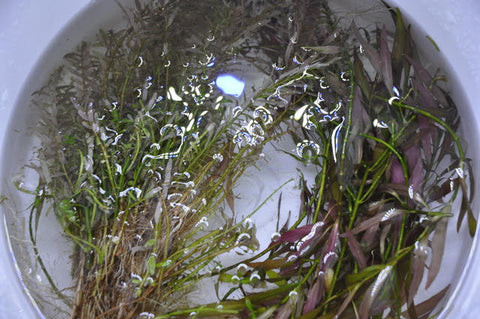
Some people don't care much about critters or algae while others volition meticulously quarantine their plants. Personally, I'm not one to quarantine/disinfect plants religiously. I only bleach dip if the plants have algae on them or come from the wild (you do not want dragonfly larvae to decimate your nano fish or shrimp population). I have 2 Carinotetraodon irrubesco that love snails. Yet, if I'thousand receiving plants from someplace I've never seen with my ain eyes or from the wild, I want to ensure that I won't introduce unwanted denizens to my aquariums.
I understand that bleach might seem likewise harsh for aquatic plants. Although, if y'all perform a quick bleach dip & make certain you rinse the plants off thoroughly,itwon't be harmful to your plants or your tank. In fact, bleach is a great plant disinfectant and volition also rid of algae! A small amount can prevent introducing whatever new algae, pests, or illness into your tank.
Disclaimer : Please keep in listen that this dipping method will focus on ridding your plants of potential hitchhikers and prominent algae, just algae can withal show up in your aquarium due to other factors.
Bleach is a powerful oxidizer, so please exist cautious when using information technology. Using gloves is a good thought. If y'all like to live dangerously, please be sure to immediately wash the afflicted area with soap and water. If bleach gets into your optics, immediately flush them with water and seek medical help. Disclaimers aside, let me get into the procedure of disinfecting your new plants!
What you will demand:
- Unscented bleach
- Dispensable gloves
- two separate containers
- Dechlorinator
Step 1: Manual Removal/Full general Prep
One time you've received your new plants, take your time to see if at that place are any snails/pests you can see and remove them.
If you run into any leaves that are melting from transport or have algae, pull them off. Depending on the type of plant you purchase, remove any lead strip or plastic pot with rock wool holding the plants.
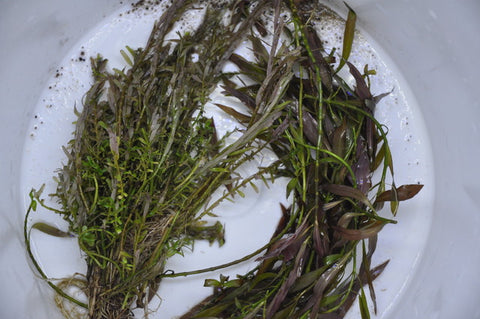
Pace ii: Rinsing Plants
Fill up a container with h2o and immerse the plants. Milkshake vigorously. This will rinse the plants of whatever loose dead leaves and/or cook you may take missed in Stride i. For more sensitive plants, rinsing them nether cool running water would be much more desirable. Repeat this step as many times every bit you'd like. Then, cascade out the unabridged contentsand rinse out the container. Ready your plants bated. 
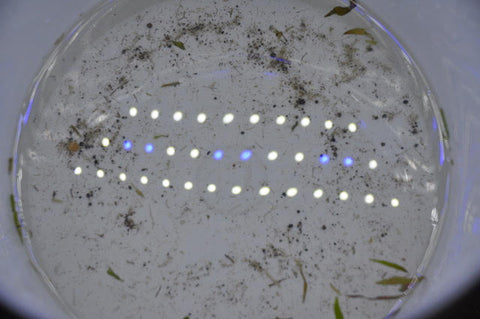
Notice the dirt and loose leaves left behind after rinse!
Pace 3: Drawing the bath
This is the dangerous part--make sure you lot're wearing your gloves. The general rule is 1 role bleach for every 20 parts of water (1:twenty ratio). Before adding the bleach, brand sure that it is unscented without whatever other added chemicals. Mix bleach and h2o together.
Footstep 4: The dip
- Notation: Before performing bleach dip, I recommend preparing your second container with fresh water and a dose of dechlorinator (dechlorinator such every bitSL- Aqua Blackness More StabilizerorSeaChem Primeare great options). This way you will be better prepared for Step 5.
Add the plants into the container with your bleach mix and make sure they're all completely submerged.
Soak times will vary depending on the plants:
Mosses, thinly leaved/delicate plants, and more than sensitive stem plants (Cryptocoryne,Utricularia Graminifolia, Hornwort, etc) should be kept under lookout man,practise not dip them for more than xc seconds.
More boilerplate plants (Echinodorus species, moststem plants,Bucephalandra species, etc) should be submerged in the bleach solution forat least 120 seconds. (Since I'm dippingRotalaandLudwigia species, I've prepare a timer for 120 seconds.)
The toughest of plants (Anubias species,Java fern) can exist dipped for 150 seconds. 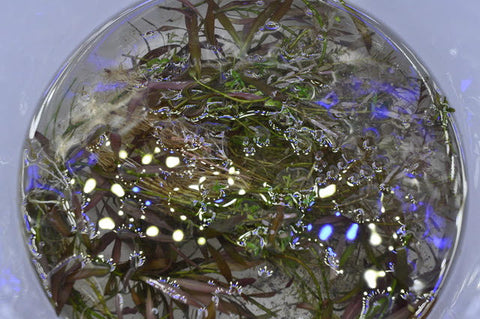
- Note: Keep in mind that all these times may affect your plants in different ways. If you are worried virtually pain your plants, y'all tin do multiple weaker/shorter dips in order to sterilize your plants.
Step five: Rinse & Dechlorinate
Before your timer rings, take your bleach dip container near a faucet. Once time is upward, immediately pull your plants from the container and completely rinse out the bleach. I like to rinse the plants make clean for at least a minute before adding them to the container of water and dechlorinator solution. Permit your plants to soak with the dechlorinator for at least a couple minutes.
Stride vi: You're done!
At this point, y'all are officially done with the bleach dip! If you're still concerned near snail eggs because of their casings, I recommend keeping the plants in a separate container/tank for a while to keep an eye on them earlier planting. You can quarantine your plants for 2-3 weeks to ensure that nothing undesired makes its way into your tank. Information technology's all up to personal preference! You can at present add your sterile plants to your aquarium if you wish.
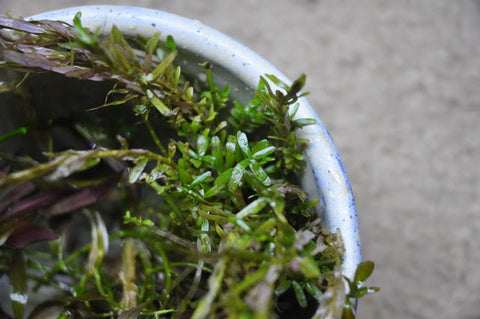
Tell us - Was this article helpful? Please comment your thoughts beneath!
If you take any questions regarding this article, please DM us on Instagram, Facebook, or email united states of america directly at support@buceplant.com so we can assist you -@buceplant
Source: https://buceplant.com/blogs/news/how-to-perform-a-bleach-dip-for-aquarium-plants
Posted by: wattsfarands.blogspot.com


0 Response to "How Much Bleach To Clean Aquarium Plants"
Post a Comment